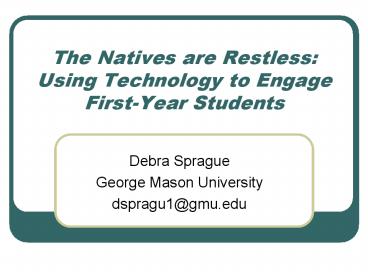The Natives are Restless: Using Technology to Engage FirstYear Students - PowerPoint PPT Presentation
1 / 22
Title:
The Natives are Restless: Using Technology to Engage FirstYear Students
Description:
On the Horizon, 9(5), 1-6. Prensky, M. (2001b, November/December) ... and trial-and-error is almost always the best plan (Beck and Wade, 2004) ... – PowerPoint PPT presentation
Number of Views:47
Avg rating:3.0/5.0
Title: The Natives are Restless: Using Technology to Engage FirstYear Students
1
The Natives are Restless Using Technology to
Engage First-Year Students
- Debra Sprague
- George Mason University
- dspragu1_at_gmu.edu
2
Who are the Digital Natives?
- A Vision of Students Today - http//youtube.com/wa
tch?vdGCJ46vyR9o - Twitch vs. Conventional Speed
- Parallel vs. Linear Processing
- Random Access vs. Linear Thinking
- Graphics First vs. Text First
- Connected vs. Stand Alone
3
- Active vs. Passive
- Payoff vs. Patience
- Fantasy vs. Reality
- Technology as friend not foe
- Prensky, M. (2001a, September/October). Digital
natives, digital immigrants. On the Horizon,
9(5), 1-6. - Prensky, M. (2001b, November/December). Digital
natives, digital immigrants, part 2 Do they
really think differently? On the Horizon, 9(6),
1-6.
4
What Do They Lack?
- They have different expectations about the world
around them. Theres always a right answer,
everything is possible, and trial-and-error is
almost always the best plan (Beck and Wade,
2004). - They are not media literate and are unable to
evaluate content, accept facts at face value. - Notions of property and privacy are shaped by
their ability to create content.
5
- People and Product rankers given rise to
cyber-bullying - Live in a state of partial attention. Not as
productive as those who stay on task. Work and
leisure merge. Have difficulty
compartmentalizing. - Rainie, L. (2006, September 28). Digital
'Natives' Invade the Workplace. Pew Research
Center. http//pewresearch.org/pubs/70/digital-nat
ives-invade-the-workplace
6
Meeting Their Learning Needs
- Use their tools for interaction and for learning
- Take time to become familiar with these tools, to
understand the potential and limitations - Do not be afraid to try even if you do not always
succeed.
7
Blogging
- Blogging or Weblogs allow students to share their
thoughts and ideas, to interact with each other
through writing. - Provide an authentic audience.
- Allows students to help each other with
coursework, builds a community. - Can use blogging sites or use Angel if you want
the audience to be limited to your students.
8
Blogging Dos
- Familiarize yourself with blogs.
- Top 100 Education Blogs - http//oedb.org/library/
features/top-100-education-blogs - Edublogs - http//edublogs.org/
- Class Blogmeister - http//classblogmeister.com/
- Recognize what blogging can do for your students.
- Transitioning from paragraphs to essays
- Exploration, discovery, and creation
9
Blogging Donts
- Dont just jump in and have students start
blogging. - Dont confuse blogging with social networking.
- Dont leap at the freebies, such as
http//www.blogger.com - Dont force a sequential style. Structure
entries by topic instead of by time. - Dont leave the blogging to the students.
- Sturgeon, J. (2008, February). Five donts of
classroom blogging. T.H.E. Journal, 35(2).
26-30.
10
Wikis
- Another tool for writing, especially
collaborative writing. - Allows users to freely create and edit Web page
content using any Web browser. - Wikipedia - http//en.wikipedia.org/wiki/Main_Page
- Technological Pedagogical Content Knowledge -
http//tpck.org/tpck/index.php?titleMain_Page - Are being used as a tool for reflection and
e-portfolios
11
Podcasts
- Audio files that can be played on the computer or
downloaded to MP3 players. - Three ways to use podcasts
- have students subscribe to and access podcasts
created by others - create your own podcasts for use by your students
- have students create their own podcasts
12
Advantages of Podcasts
- Allow students to easily review material for a
test or to learn material they missed due to
absence - Useful for language development
- Allow students to publish their ideas to a
broader audience - Allows students to be actively involved in their
own learning
13
Issues with Podcasts
- Have a steep learning curve if creating your own.
- Creating a podcast takes time.
14
Accessing Podcasts
- If you wish to access podcasts created by others
or learn more about podcasting check out the
following sites - Education Podcast Network - http//www.epnweb.org/
- iTunes Store - http//www.apple.com/itunes/store/p
odcasts.html - Podcast Alley - http//www.podcastalley.com/
- Podscope - http//podscope.com/
15
Digital Stories
- Turns a personal narrative into a multimedia
experience - Can be used to introduce or reinforce the power
of writing - Easy to use and incorporate into the classroom
- Photostory - http//www.microsoft.com/windowsxp/us
ing/digitalphotography/photostory/default.mspx - iMovie - http//www.apple.com/ilife/imovie/
16
Digital Stories Resources
- Digital Stories - http//www.digitalstories.org/
- Center for Digital Storytelling -
http//www.storycenter.org/ - Educational Uses of Digital Storytelling -
http//www.coe.uh.edu/digital-storytelling/
17
Collaboration Tools
- Course Management tools Angel, Blackboard,
WebCT - Pubcasts on SciVee - http//www.scivee.tv/
- GenePattern - http//www.broad.mit.edu/cancer/soft
ware/genepattern/ - Engineering Village - http//www.engineeringvillag
e2.org/controller/servlet/Controller
18
Collaborative Writing Tools
- Online Writing Collaboration Project -
http//www.owcp.net/ (For English teachers) - Guide to Collaborative Writing Tools -
http//www.kolabora.com/news/2007/03/01/collaborat
ive_writing_tools_and_technology.htm
19
Virtual Environments
- Second Life - http//secondlife.com/
- Active Worlds - http//activeworlds.com/
- There - http//www.there.com/
- Dimension M - http//www.dimensionm.com/
- River City - http//muve.gse.harvard.edu/muvees200
3/ - Virtual Environments.info - http//www.virtualenvi
ronments.info/
20
Augmented Reality
- Interaction between the real world and the
virtual world - Requires handhelds and GPS systems
- A variety of simulations where participants
collaborate to solve a problem - Interact with virtual characters and data
21
Augmented Reality Resources
- Handheld Augmented Reality Project (HARP) -
http//www.isites.harvard.edu/harp - Local games lab - http//www.lgl.gameslearningsoci
ety.org/ - Augmented Reality Games - http//www.educationarca
de.org/aurg
22
Additional Information on Digital Natives
- Digital Natives - http//www.digitalnative.org/Mai
n_Page - Digital Natives in the Classroom -
http//coe.sdsu.edu/eet/articles/digitalnatives/in
dex.htm - Digital Native or Digital Immigrant, Which
Language Do You Speak? -http//www.nacada.ksu.edu/
clearinghouse/AdvisingIssues/Digital-Natives.htm































